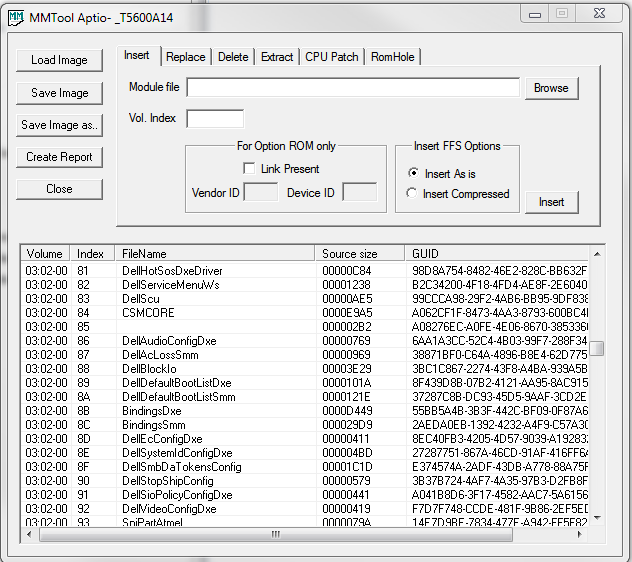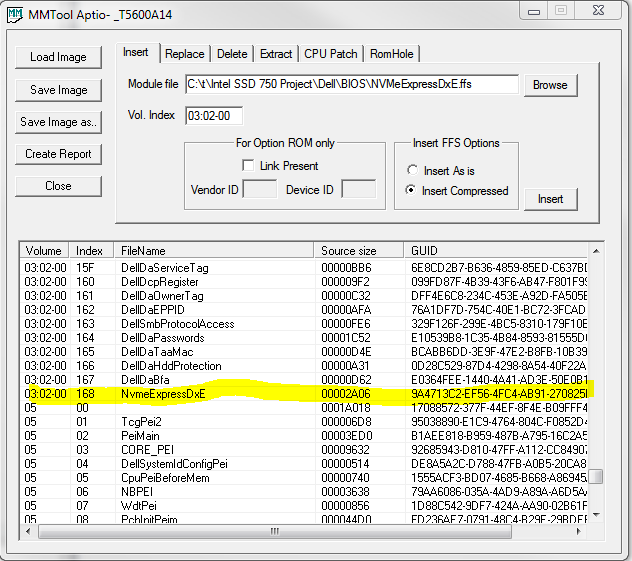Thanks for the information "Fernando". I will post back my results, and experience.
Keep up the great site!
As an update I had e-mailed AsRock and they sent me a beta bios with NVMe support and it works dandy now. For anyone else with IMB181L that would like this UEFI
IMB181L(P1.90A)ROM.zip (4.78 MB)
Hi,
I’d like to mod an AsRock Z68 Extreme4 board, for using with a Samsung 950 Pro.
I know that i don’t have a M.2 connector, so i’m planning to use this adapter: Aqua Computer kryoM.2 PCIe 3.0 x4 (it even comes with a heatsink ![]() ). I even know that my motherboard doesn’t have PCI-e 3.0 but only 2.0, so i’m going to use the PCI-E port 5 that is a x4 dedicated, or the PCI-E port 4 that it’s a x16 shared with the vga (x8 and x8 if both are connected). The 950 performance will suffer a bit, but they’ll be still bettern than my crucial m4 128.
). I even know that my motherboard doesn’t have PCI-e 3.0 but only 2.0, so i’m going to use the PCI-E port 5 that is a x4 dedicated, or the PCI-E port 4 that it’s a x16 shared with the vga (x8 and x8 if both are connected). The 950 performance will suffer a bit, but they’ll be still bettern than my crucial m4 128.
Before I will try to flash my Bios, do i need to modify my bios? I’ve read that the 950 Pro can use a legacy mode for operate with old board.
Has anyone tryed to use the 950 Pro with a Z68?
Has anyone tryed to mod this motherboard for the NVMe support?
Will it boot from it?
Thx,
Stefano.
@evil_stefano :
Hello Stefano,
welcome at Win-RAID Forum!
Yes, if you want to get the OS installed in UEFI mode.
I am not sure, if it will work for your system out of the box. My tests with my ASUS Z68 mainboard failed as long as I used the untouched BIOS.
Yes, after having inserted the NvmeExpressDxE.ffs module I succeeded with the OS installation onto the Samsung 950 Pro SSD in UEFI mode.
Good luck!
Dieter (alias Fernando)
Not sure if this is off topic.
I have an Asrock Z77 Extreme6 and the latest beta bios works fine as is with the Samsung 950 Pro.
Latest bios is currently P2.80E found here. http://www.asrock.com/mb/Intel/Z77%20Extreme6/?cat=Beta
There is little information on this board and NVMe booting with the beta bios, the only search results i found were failures.
I am also waiting on some parts to get a Gigabyte X79-UP4 running, ill advise if i can get it to work with NVMe booting a 128GB SM951. I expect it will work just fine with the module inserted.
UPDATE
The Asrock Z77 Extreme6 worked fine with the 950 Pro in pure UEFI mode BUT wouldn’t detect the SM951, the bios doesn’t have enough space to insert the NVMe mod BUT if you update the bios with UBU first there is enough space to insert the NVMe mod.
Thanks Fernando for a very helpful guide and for the Forum in general. You say “Some NVMe SSDs like Samsung’s 950 Pro SSD are natively bootable in LEGACY mode (CSM and loading of Option ROMs has to be enabled within the BIOS), because their Controller chip contains its own NVMe supporting Option ROM module.” I have a Gigabyte GA-X79-UD5 motherboard and at first could not verify this. No matter what I did in the BIOS settings the Samsung 950 PRO SSD drive in my system would not appear. Until I changed the Intel SATA settings; if it is anything but RAID the Samsung appears as “N1 - Samsung SSD PRO 512GB”. But if I change Intel SATA to RAID, the Samsung does not appear. I have two RAID volumes mounted on my Intel SATA ports in this machine, so the option of turning off RAID does not exist for me. I modded my BIOS following your directions, and now the Samsung appears as a PATA drive. I have not been able to boot from it after simply imaging my boot drive to the Samsung using Casper, but that is probably because I still have the old system disk in the computer.
I was wondering if you had any thoughts about the Samsung in Legacy mode not appearing when Intel RAID is enabled?
@helzayat :
Welcome at Win-RAID Forum!
I don’t know the exact reason, but there is obviously an incompatibility between the SSD own NVMe Option ROM and the Intel RAID ROM, which is part of the mainboard BIOS.
Possible solutions:
a) installation of the OS in UEFI mode (requires a suitable EFI NVMe module within the mainboard BIOS chip) or
b) setting the Intel SATA Controller to "AHCI" or "IDE" (if applicable).
Regards
Dieter (alias Fernando)
Hi, do you think it is possible to get NVMe boot support in AsRock C226 WS+? I will try to contact Asrock, but just in case this would not be successful…
@dadaniel :
Welcome at Win-RAID Forum!
Yes, I think, that it will be possible.
Good luck!
Dieter (alias Fernando)
Followed the steps with my MSI Z87-GAMING with SM951(nvme, duh). Works like a charm!!
@hchuang :
Welcome at Win-RAID Forum and thanks for your report!
It is fine, that you succeeded by following my guide.
Enjoy the performance of the Samsung SM951 NVMe with your Z87 system!
Regards
Dieter (alias Fernando)
I wrote to Gigabyte eSupport but I’m not holding my breath waiting for an answer. Adding the NVMe module as per your guide allowed me to install the OS on the Samsung PRO 950 and boot from it, while keeping the Intel SATA controller in RAID mode.
.
@SubZero :
Welcome at Win-RAID Forum!
Although there is no guarantee, I am pretty sure, that you will succeed, if you have followed my guide.
Good luck!
Dieter (alias Fernando)
Gigabyte X79-UP4 booting from NVMe fine with the added modules
Thanks for the information “Fernando”. I will post back my results, and experience.
Keep up the great site!
Hello again Fernando. I have learned a lot about the process. I’m close to giving it a try really don’t want to brick my system, so I’m being extra careful.
I feel like I’m quite close to putting all the pieces together, but I always seem to encounter some sort of obstacle, or question that creates doubt about the process.
Currently, that issue seems to be extracting the HDR and Rom file from the DELL flasher.exe. The much cited /writehdrfile and writeromfile don’t seem to be supported by the DELL T5600A14.exe file I need to use.
I used PhoenixTool 2.66, and it seemed to be successful parsing out all the particulars, but instead of two files output like I expected, I now have the following.
T5600A14 (with no extension) That looks like the HDR file.
DUMP directory with 1129 ROM files
DUMP\BIOS directory with 357 BIOS
SLIC.LOG (Attached)
The number of files doesn’t really bother me, but when it comes to introducing NVMeExpressDxE.ffs, file I am unclear how to proceed.
Assuming there is a way to introduce the microcode, I am also unclear how to package the modified BIOS into something that can be flashed.
Ideally, I think it would be great if the mod could be returned to the original exe form and flashed that way, but that seems unlikely.
So could you lend some ideas or directions on how to proceed?
Thanks again.
SLIC.zip (61.6 KB)
I am sorry, but I cannot help you (due to missing experience with andyp’s PhoenixTool).
Perhaps I got off track a little.
I’m not committed to using andyp’s tool, I just mention it because I’ve seen it used here on the forum and had a certain amount of success using it to extract the files (I believe) I need.
So here are the things I could some clarity on.
When extracting from the flasher exe how many files should I expect? I seem to obtain just one. Is that okay?
Following the guide, when I open the file in MMTool I see that the volume is specified differently than I see in other examples ‘03:02-00’. Good?
Also following the guide, when I add the NVMeExpressDxE.ffs, and save it I was a little surprised that the size of the file remained unchanged. Good?
So assuming all is well at this point, how do I get this new file flashed? Should I be looking at getting this file back into the flasher exe, or pursue flashing it by other means?
As I mentioned, this is my development machine. I don’t mind failing and using the drive as a data drive, but I can’t afford to brick the box.
Those are my questions, and I include some files and screen shots.
Thanks again for your time.


T5600A14.zip (5.41 MB)
I don’t know it, because I don’t have a Dell computer.
Yes!
The total size of the BIOS must stay absolutely unchanged by any modding procedure. When you insert an original not present BIOS odule, the other modules will be a little bit more compressed - that is all. If there should be not enough space to get any additional module inserted, the AMI Aptio MMTool will give you a "not enough space" message and will not execute the demanded task.
You should revert it into the original form.
The risks of a bricked mainboard is very low, because you haven’t replaced or removed any original present BIOS module. The problem may be to circumvent Dell’s security mechanism to prevent any flashing of a modded BIOS.
Thanks again. All your responses make perfect sense.
It looks like only getting a single .hdr file is fine in this Dell’s case. So all I have to do is get the mod flashed.
I agree, Dell has obstacles in place to prevent you from flashing a modified BIOS. That seems a little unfair to do this since they don’t back and update older BIOS’s with new features like NVMe.
It looks like linux users have inherently the same issue, since they cant run the flasher exes. So I’m looking into flashing it that way.
I’ll let you know how it goes. I think it will work.
Thanks for all your help.